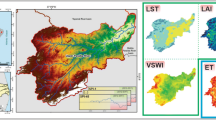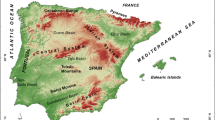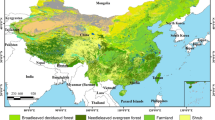Abstract
Understanding the dynamics of the earth’s surface variation patterns has been critical for climate change adaptation and mitigation. During the last decades, detecting these events through remote sensing allowed us to improve the conventional analysis toward an integrated space–time analysis. This chapter proposes a spatiotemporal exploratory analysis of the information from SPI, SPEI and links its results into remote sensing information of NDVI using computer vision algorithms for pattern recognition and tracking. This analysis was carried out in three phases. First, a 20-year analysis of vegetation-based indices (NDVI) and meteorological drought indices (SPI, SPEI), to identify and compare the water anomalies over Central America dry corridor, using ERA5 climatological information and satellite images for the period 2000–2020. These results are used to assess the spatiotemporal variations of meteorological stress and vegetation water stress. All this is analyzed considering the conditions along the phenological cycle. The implementation of the spatiotemporal drought methodology proposed by Corzo and Vitali, 2018, and its results used as input time series, through LOWESS smoothing proposed by Jong (Remote Sens Environ 115(2):692–702, 2011). The final comparison uses statistical metrics such as spatial correlation. Drought units are identified for each meteorological drought index and are compared among them, and together with the NDVI normalization, a vegetation-based drought index (vegetation condition index or VCI) is estimated. This step allows representing the phenological conditions of vegetative water stress without interferences of temporality and consistency. Finally, the VCI is classified in categorical ranges that allow the comparison of drought units to the SPI in different lags (1, 3, 6) and SPEI (1, 3, 6). By this, establishing meteorological relationships with the vegetative surface dynamics and generating the trajectories (tracking) of each drought cluster observed with the VCI. Finally, a validation of the trajectories are also compared. All validation show that his methodology allows using directly inferred drought from remote sensing as a meteorological drought index, in similar way as SPI. The spatiotemporal changes monitoring and evaluation associated with land cover and water sources, and derivation of drought index based on vegetative condition is an essential component of this chapter’s contribution.
Access this chapter
Tax calculation will be finalised at checkout
Purchases are for personal use only
Similar content being viewed by others
References
Aguilar E et al (2005) Changes in precipitation and temperature extremes in Central America and northern South America, 1961–2003. J Geophys Res Atmos 110(23):1–15. https://doi.org/10.1029/2005JD006119
Al-Shujairy QAT, Al-Hedny S, Al-Barakat H, Hao Y, Hao Z, Fu Y (2019) Drounght analysis by using standarized precipitation index (SPI) and normalized difference vegetation index (NDVI) at Bekasi Regency in 2018. IOP Conf Ser Earth Environ Sci 280(1):012002. https://doi.org/10.1088/1755-1315/280/1/012002
Anandhi A, Srinivas VV, Nanjundiah RS, Nagesh Kumar D (2008) Downscaling precipitation to river basin in India for IPCC SRES scenarios using support vector machine. Int J Climatol 28(3):401–420. https://doi.org/10.1002/joc.1529
Anderson TG, Anchukaitis KJ, Pons D, Taylor M (2019) Multiscale trends and precipitation extremes in the Central American midsummer drought. Environ Res Lett 14(12):124016. https://doi.org/10.1088/1748-9326/ab5023
Bacanli UG, Firat M, Dikbas F (2009) Adaptive neuro-fuzzy inference system for drought forecasting. Stoch Environ Res Risk Assess. https://doi.org/10.1007/s00477-008-0288-5
Bae S, Lee SH, Yoo SH, Kim T (2018) Analysis of drought intensity and trends using the modified SPEI in South Korea from 1981 to 2010. Water (Switzerland) 10(3). https://doi.org/10.3390/w10030327
Baniya B, Tang Q, Xu X, Haile GG, Chhipi-Shrestha G (2019) Spatial and temporal variation of drought based on satellite derived vegetation condition index in Nepal from 1982–2015. Sensors (Switzerland) 19(2). https://doi.org/10.3390/S19020430
Beck HE et al (2017) Global-scale evaluation of 22 precipitation datasets using gauge observations and hydrological modeling. Hydrol Earth Syst Sci 21(12):6201–6217. https://doi.org/10.5194/hess-21-6201-2017
Belayneh A, Adamowski J, Khalil B, Ozga-Zielinski B (2014) Long-term SPI drought forecasting in the Awash River Basin in Ethiopia using wavelet neural networks and wavelet support vector regression models. J Hydrol. https://doi.org/10.1016/j.jhydrol.2013.10.052
Blain GC (2011) Standardized precipitation index based on Pearson type III distribution. Rev Bras Meteorol 26(2):167–180. https://doi.org/10.1590/s0102-77862011000200001
Buttafuoco G, Caloiero T (2014) Drought events at different timescales in Southern Italy (Calabria). J Maps 10(4):529–537. https://doi.org/10.1080/17445647.2014.891267
Cai W (2014) Increasing frequency of extreme El Niño events due to greenhouse warming. Nat Clim Chang 4(2):111–116. https://doi.org/10.1038/nclimate2100
Cai Z, Jönsson P, Jin H, Eklundh L (2017) Performance of smoothing methods for reconstructing NDVI time-series and estimating vegetation phenology from MODIS data. Remote Sens 9(12). https://doi.org/10.3390/RS9121271
Colliander A et al (2017) Validation of SMAP surface soil moisture products with core validation sites. Remote Sens Environ. https://doi.org/10.1016/j.rse.2017.01.021
Cook BI, Mankin JS, Anchukaitis KJ (2018) Climate change and drought: from past to future. Curr Clim Chang Reports 4(2):164–179. https://doi.org/10.1007/S40641-018-0093-2
Corzo G (2019) Framework for spatio-temporal multi-objective optimization of preventive drought management measures. PhD research proposal
de Jong R, de Bruin S, de Wit A, Schaepman ME, Dent DL (2011) Analysis of monotonic greening and browning trends from global NDVI time-series. Remote Sens Environ 115(2):692–702. https://doi.org/10.1016/J.RSE.2010.10.011
Depsky N, Pons D (2020) Meteorological droughts are projected to worsen in Central America’s Dry Corridor throughout the 21st century. Environ Res Lett 16(1):014001. https://doi.org/10.1088/1748-9326/ABC5E2
Diaz V, Corzo Perez GA, Van Lanen HAJ, Solomatine D, Varouchakis EA (2020a) Characterisation of the dynamics of past droughts. Sci Total Environ https://doi.org/10.1016/j.scitotenv.2019.134588
Diaz V, Corzo Perez GA, Van Lanen HAJ, Solomatine D, Varouchakis EA (2020b) An approach to characterise spatio-temporal drought dynamics. Adv Water Resour. https://doi.org/10.1016/j.advwatres.2020.103512
Dominguez C, Magaña V (2018) The role of tropical cyclones in precipitation over the tropical and subtropical North America. Front Earth Sci 6. https://doi.org/10.3389/FEART.2018.00019/FULL
Dracup JA, Lee KS, Paulson EG (1980) On the definition of droughts. Water Resour Res. https://doi.org/10.1029/WR016i002p00297
Dutra DJ, Elmiro MAT, Coelho CWGA, Nero MA, Temba PDC (2021) Temporal analysis of drought coverage in a watershed area using remote sensing spectral indexes. Soc Nat 33. https://doi.org/10.14393/SN-V33-2021-59505
Ebrahimi M, Matkan AA, Darvishzadeh R (2010) Remote sensing for drought assessment in Arid regions (A case study of central part of Iran, “Shirkooh-Yazd”)
Eckstein D, Hutfils M-L, Winges M (2017) Germanwatch
Entekhabi D et al (2010) The soil moisture active passive (SMAP) mission. Proc IEEE. https://doi.org/10.1109/JPROC.2010.2043918
Fallah A, Rakhshandehroo GR, Berg POS, Orth R (2020) Evaluation of precipitation datasets against local observations in southwestern Iran. Int J Climatol 40(9):4102–4116. https://doi.org/10.1002/joc.6445
FAO (2019) Global report on food crises. Food Secur Inf Netw
Frieler K et al (2017) Assessing the impacts of 1.5 °C global warming—simulation protocol of the inter-sectoral impact model intercomparison project (ISIMIP2b). Geosci Model Dev 10(12):4321–4345. https://doi.org/10.5194/gmd-10-4321-2017
Ghulam A, Qin Q, Zhan Z (2007) Designing of the perpendicular drought index. Environ Geol 52(6):1045–1052. https://doi.org/10.1007/S00254-006-0544-2
Gong F et al (2022) Partitioning of three phenology rhythms in American tropical and subtropical forests using remotely sensed solar-induced chlorophyll fluorescence and field litterfall observations. Int J Appl Earth Obs Geoinf 107. https://doi.org/10.1016/j.jag.2022.102698
Habibi M, Schöner W, Babaeian I (2020) Drought monitoring using standardized precipitation index (SPI), standardized precipitation-evapotranspiration index ( SPEI ) and normalized-difference snow index ( NDSI ) with observational and ERA5 dataset, within the uremia lake basin, Iran. 11543
Hafni DAF et al (2022) Peat fire risk assessment in Central Kalimantan, Indonesia using the standardized precipitation index (SPI). IOP Conf Ser Earth Environ Sci 959(1). https://doi.org/10.1088/1755-1315/959/1/012058
Herrera-Estrada JE, Satoh Y, Sheffield J (2017) Spatiotemporal dynamics of global drought. Geophys Res Lett. https://doi.org/10.1002/2016GL071768
Hilda F (2017) Drought analysis for mitigating Peatland fires using satellite data based on geographic information systems. JOM FTEKNIK 4(2):1–9
Hydrologic remote sensing: capacity building for sustainability and resilience—Google Libros. https://books.google.com.co/books?id=jyINDgAAQBAJ&pg=PA265&lpg=PA265&dq=(Ghulam+et+al.,+2007).&source=bl&ots=-mrnulrLQ8&sig=ACfU3U3G0Xde_zS-aQuR_YAlO-_2XPg58A&hl=es-419&sa=X&ved=2ahUKEwiGjIDt2ej3AhX0SDABHf-vBAUQ6AF6BAgZEAM#v=onepage&q=(Ghulametal.%2C2007)&f=false. Accessed 18 May 2022
Jiang Y et al (2017) Analysis of relationship between meteorological and agricultural drought using standardized precipitation index and vegetation health index. IOP Conf Ser Earth Environ Sci 54(1):012008. https://doi.org/10.1088/1755-1315/54/1/012008
Jiao W, Zhang L, Chang Q, Fu D, Cen Y, Tong Q (2016) Evaluating an enhanced vegetation condition index (VCI) based on VIUPD for drought monitoring in the continental united states. Remote Sens 8(3):224. https://doi.org/10.3390/RS8030224
Kogan F (1997) Global drought watch from space. https://web.iitd.ac.in/~sagnik/C2.pdf. Accessed 23 Sep 2021
Maldonado T, Rutgersson A, Alfaro E, Amador J, Claremar B (2016) Interannual variability of the midsummer drought in Central America and the connection with sea surface temperatures. Adv Geosci. https://doi.org/10.5194/adgeo-42-35-2016
Murakami H et al (2016) Seasonal forecasts of major hurricanes and landfalling tropical cyclones using a high-resolution GFDL coupled climate model. J Clim. https://doi.org/10.1175/JCLI-D-16-0233.1
Nejadrekabi M, Eslamian S, Zareian MJ (2022) Spatial statistics techniques for SPEI and NDVI drought indices: a case study of Khuzestan Province. Int J Environ Sci Technol. https://doi.org/10.1007/S13762-021-03852-8
Nihoul JCJ (2005) Marine ecosystems and climate variation. J Mar Syst. https://doi.org/10.1016/j.jmarsys.2004.06.004
Okal HA, Ngetich FK, Okeyo JM (2020) Spatio-temporal characterisation of droughts using selected indices in Upper Tana River watershed, Kenya. Sci African 7:e00275. https://doi.org/10.1016/j.sciaf.2020.e00275
Peters A, Walter-Shea E, Ji L, Viña A, Hayes M, Svoboda M (2002) Drought Monitoring with NDVI-Based standardized vegetation index. Undefined
Podestá G, Skansi M, Herrera N, Veiga H (2016) Descripción de índices para el monitoreo de sequía meteorológica implementados por el Centro Regional del Clima para el Sur de América del Sur. Rep Técnico CRC-SAS
Poornima S, Pushpalatha M (2019) Drought prediction based on SPI and SPEI with varying timescales using LSTM recurrent neural network. Soft Comput. https://doi.org/10.1007/s00500-019-04120-1
Prasetyo Y, Bashit N, Simarsoit Y (2019) Study of correlation of residential and industrial growth pattern in Semarang city to the aquifer capacity changes in the year 2014–2017. IOP Conf Ser Earth Environ Sci 280(1). https://doi.org/10.1088/1755-1315/280/1/012001
Rokhmatullah, Hernina R, Yandi S (2018) Drounght analysis by using standarized precipitation index (SPI) and normalized difference vegetation index (NDVI) at Bekasi Regency in 2018. IOP Conf Ser Earth Environ Sci. https://doi.org/10.1088/1755-1315/280/1/012002
Sahaar SA, Niemann JD (2020) Impact of regional characteristics on the estimation of root-zone soil moisture from the evaporative index or evaporative fraction. Agric Water Manag 238. https://doi.org/10.1016/J.AGWAT.2020.106225
Sánchez Hernández KA (2021) Biblioteca Jorge Álvarez Lleras Koha › Detalles de: machine learning methods for characterising and tracking spatiotemporal drought events case study: Central America Dry Corridor . https://catalogo.escuelaing.edu.co/cgi-bin/koha/opac-detail.pl?biblionumber=22675. Accessed 18 May 2022
Serda M (2013) Synteza i aktywność biologiczna nowych analogów tiosemikarbazonowych chelatorów żelaza. Uniw śląski 343–354. https://doi.org/10.2/JQUERY.MIN.JS
Sexton JO et al (2013) Global, 30-m resolution continuous fields of tree cover: landsat-based rescaling of MODIS vegetation continuous fields with lidar-based estimates of error. Int J Digit Earth. https://doi.org/10.1080/17538947.2013.786146
Sheffield J, Andreadis KM, Wood EF, Lettenmaier DP (2009) Global and continental drought in the second half of the twentieth century: severity-area-duration analysis and temporal variability of large-scale events. J Clim. https://doi.org/10.1175/2008JCLI2722.1
Soudani K et al (2012) Ground-based Network of NDVI measurements for tracking temporal dynamics of canopy structure and vegetation phenology in different biomes. Remote Sens Environ 123:234–245. https://doi.org/10.1016/J.RSE.2012.03.012
Sutanto SJ, Wetterhall F, Van Lanen HAJ (2020) Hydrological drought forecasts outperform meteorological drought forecasts. Environ Res Lett 15(8). https://doi.org/10.1088/1748-9326/AB8B13
Tadesse T, Wardlow B, Svoboda MD, Hayes MJ (2012) Vegetation outlook (VegOut): predicting remote sensing–based seasonal greenness. Drought Mitigation Center Faculty Publications [Online]. Available: https://digitalcommons.unl.edu/droughtfacpub/102. Accessed 18 May 2022
To reduce El Niño’s impact on Central America’s Dry Corridor, build resilience and invest in sustainable agriculture. https://www.ifad.org/es/web/latest/-/news/to-reduce-el-nino-s-impact-on-central-america-s-dry-corridor-build-resilience-and-invest-in-sustainable-agriculture. Accessed 18 May 2022
van der Zee Arias A, van der Zee J, Meyrat A, Poveda C, Picado L (2012) Estudio de caracterización del Corredor Seco Centroamericano. p 70 [Online]. Available: https://reliefweb.int/sites/reliefweb.int/files/resources/tomo_i_corredor_seco.pdf
Van Loon AF (2015) Hydrological drought explained. Wiley Interdiscip Rev Water. https://doi.org/10.1002/wat2.1085
World Food Programme (2022) Erratic weather patterns in the Central American Dry Corridor leave 1.4 million people in urgent need of food assistance. https://www.wfp.org/news/erratic-weather-patterns-central-american-dry-corridor-leave-14-million-people-urgent-need. Accessed 18 May 2022
Wilhite D (2006) Drought monitoring and early warning: concepts, progress and future challenges. World Meteorogical Organ
Zhang J et al (2022) NIRv and SIF better estimate phenology than NDVI and EVI: effects of spring and autumn phenology on ecosystem production of planted forests. Agric for Meteorol 315:108819. https://doi.org/10.1016/J.AGRFORMET.2022.108819
Zhang A, Jia G, Wang H (2019) Improving meteorological drought monitoring capability over tropical and subtropical water-limited ecosystems: evaluation and ensemble of the microwave integrated drought index. Environ Res Lett 14(4). https://doi.org/10.1088/1748-9326/AB005E
Zhao M, Heinsch FA, Nemani RR, Running SW (2005) Improvements of the MODIS terrestrial gross and net primary production global data set. Remote Sens Environ. https://doi.org/10.1016/j.rse.2004.12.011
Acknowledgements
We would like to thank the IHE-Delft and Escuela Colombiana de IngenieriaJulio Garavito for funding this research. Also, thanks for the support to the hydro informatics research group, Dr. Gerald Augusto Corzo Perez, especially to reviewers and editors for their valuable comments, which helped to improve the quality of this manuscript.
Data and Code Statement
Data used and Codes developed in this study are available upon request.
Author information
Authors and Affiliations
Corresponding author
Editor information
Editors and Affiliations
Rights and permissions
Copyright information
© 2022 The Author(s), under exclusive license to Springer Nature Switzerland AG
About this chapter
Cite this chapter
Hernández, K.A.S., Perez, G.A.C. (2022). A Comparative Analysis of Spatiotemporal Drought Events from Remote Sensing and Standardized Precipitation Indexes in Central America Dry Corridor. In: Singh, V.P., Yadav, S., Yadav, K.K., Corzo Perez, G.A., Muñoz-Arriola, F., Yadava, R.N. (eds) Application of Remote Sensing and GIS in Natural Resources and Built Infrastructure Management. Water Science and Technology Library, vol 105. Springer, Cham. https://doi.org/10.1007/978-3-031-14096-9_5
Download citation
DOI: https://doi.org/10.1007/978-3-031-14096-9_5
Published:
Publisher Name: Springer, Cham
Print ISBN: 978-3-031-14095-2
Online ISBN: 978-3-031-14096-9
eBook Packages: Earth and Environmental ScienceEarth and Environmental Science (R0)




